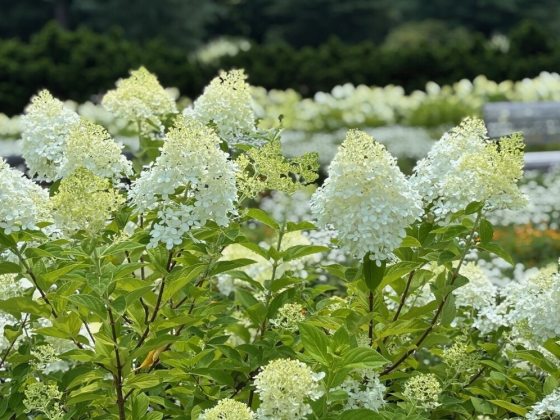
Featured Bloom
Panicle Hydrangea
Hydrangea paniculata ‘Limelight’ is a well-known cultivar selected by Proven Winners for its reliable performance and striking blooms. Originally developed in the Netherlands, it features large, upright panicles of flowers that open a distinctive pale green in midsummer before gradually shifting to creamy white, pink, and rose tones as the season progresses. This deciduous shrub is adaptable to a variety of soil types and thrives in full sun to partial shade. Growing 6 to 8 feet tall and wide, 'Limelight' is appreciated for its strong stems, long bloom period, and suitability for both garden use and cut flower arrangements.
See what’s in bloom … and enjoy the beauty of our Gardens.
-

Franklinia
Franklinia alatamahaFranklinia, or the Franklin tree is a small deciduous tree in the camellia family. It was first discovered by the Philadelphia based botanists John and William Bartram on the banks of the Alatamaha River in Georgia in 1765. William Bartram collected seed in 1773, and successfully cultivated the plant at the Bartram gardens in Philadelphia. Bartram named the new plant Franklinia alatamaha in honor of his father’s friend Benjamin Franklin. It is a unique tree as it is the only species in its genus, and it is now extinct in the wild. The original stand of trees was restricted to a small area and the species went extinct soon after its discovery, with the last confirmed sighting recorded in 1803. The probable causes for its demise were increased activity associated with settlers; for example fires and land clearance. All known living specimens in cultivation today are descended from the seed collected by William Bartram. Interestingly, while the tree was discovered in Georgia, it performs well in more northern climates. It has therefore been hypothesized that the tree was pushed south during the last ice age, then stranded when the ice retreated. The trees that the Bartrams discovered might have been the last remnants of a once much larger population. The Franklin tree is available commercially and is prized in cultivation for both its story and its fragrant camellia-like flowers and red fall foliage.
-
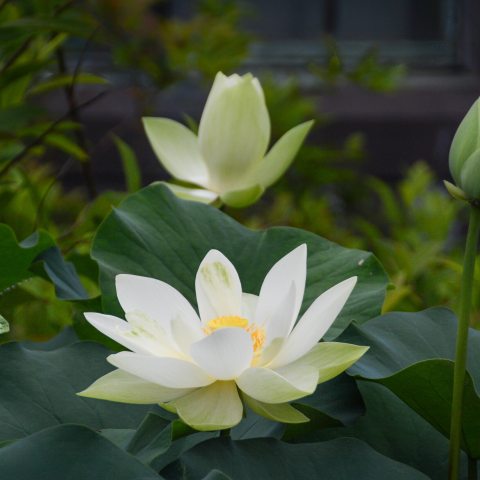
Hybrid White Lotus
Nelumbo ′Perry’s Giant Sunburst′Known for their beauty, the highly ornamental flowers of lotus are extremely fragrant and symbolic in many cultures. Emerging from the murky waters into the bright clear day is how Nelumbo nucifera, also referred to as the sacred lotus, first became a symbol of enlightenment. The fact that the sacred lotus is able to emerge without any trace of the muddy depths from which it was born is how it became associated with purity. Further elevating its sacred status, it’s reputed that Buddha rose up from the heart of a lotus bud more than 2,500 years ago.
-

Straight Cactus Dahlia
Dahlia 'Lemon Tart'Dahlias are native to the highlands of Mexico and Central America, where they were cultivated by the Aztecs long before European contact, for their beauty, and also for their edible tubers and symbolic meaning. The Aztecs saw dahlias as a symbol of strength, dignity, and resilience. When Spanish botanists brought dahlias to Europe in the 18th century, they quickly captivated gardeners with their endless variety of shapes and colors. Today, the dahlia is Mexico’s national flower and a global garden favorite. Find a variety of dahlias on display throughout the gardens.
-

Clustered Mountain-mint
Pycnanthemum muticumPycnanthemum muticum is an underused plant, native to Eastern North America and can be found growing in open grassy places such as meadows and fields. The leaves, when crushed, give off a minty aroma similar to spearmint. This plant can be used to make tea, and was traditionally used by indigenous people for treating illnesses such as fevers, colds, and other physical ailments. While not particularly showy, this plant is very popular with pollinators, particularly bees, and is a vigorous and easy grower. Mountain mint is an outstanding filler plant in a flower arrangement!
-

Clammy Azalea
Rhododendron viscosumRhododendron viscosum, also known as the clammy or swamp azalea, is a fragrant, summer-blooming shrub, native to the eastern United States. Unlike many rhododendrons that flower in spring, this late bloomer perfumes the warm air with its spicy-sweet, clove-like scent in mid-to-late summer. Its delicate white to pale pink flowers are sticky (hence the name viscosum, meaning "sticky" in Latin), attracting butterflies and hummingbirds. Preferring wet, acidic soils and partial shade, it thrives in bogs and woodland edges, making it a charming shrub with a love for the swampy side of life!
-

Rose Mallow
Hibiscus ′Summer Storm′‘Summer Storm’ is a hardy rose mallow hybrid with large flowers up to 10 inches across, that blooms from July to September. These flowers which attract hummingbirds stand out against the plant’s dark purple foliage. Rose mallows can grow to 7 feet tall and perform best in moist soils and full sun. You may associate hibiscus with tropical plants, but within the parentage of ‘Summer Storm’ are species of hibiscus native the eastern United States.
-

Giant-hyssop
Agastache ′Blue Fortune′Agastache is a genus of about 20 species, native to eastern Asia and North America, and grows in dry woodland and prairies, old fields, dry scrub and hills. ‘Blue Fortune’ is a hybrid cross between Agastache rugosa and Agastache foeniculum. It grows up to 36 inches tall and spreads up to 24 inches wide and produces a mass of soft purple, upright tubular flowers in spikes to five inches long from June to October, attracting a plethora of pollinators. Giant-hyssop prefers full sun and grows well in average to dry soil conditions.
-

Purple Coneflower
Echinacea purpurea 'White Swan'Unlike the typical purple blooms of the species, 'White Swan' features striking white petals surrounding a prominent orange-brown central cone. Blooming from mid to late summer, it attracts a wide range of pollinators, including bees, butterflies, and other beneficial insects, making it a valuable addition to pollinator-friendly gardens. Its sturdy stems and long-lasting flowers also make it a popular choice for cut flower arrangements. Like its wild counterparts, 'White Swan' thrives in full sun and well-drained soils, and it’s drought-tolerant once established. Echinacea has a long history of traditional medicinal use, particularly among Native American tribes, though 'White Swan' is primarily cultivated for its ornamental appeal.
-

Nong Nooch-vine
Petraeovitex bambusetorumPetraeovitex bambusetorum, commonly referred to as the Nong Nooch-vine, is a rare and ornamental woody climber native to parts of Southeast Asia. It is notable for its attractive, arching flower spikes that feature a combination of yellow and purple hues, offering visual interest throughout the blooming period. The plant belongs to the mint family (Lamiaceae), although its appearance is quite distinct from typical members of that group. It gained attention and its common name from the Nong Nooch Tropical Botanical Garden in Thailand, where it has been cultivated and displayed. This vine prefers tropical to subtropical climates, thrives in warm, humid conditions, and is often used as a botanical curiosity in specialty gardens or collections.
-
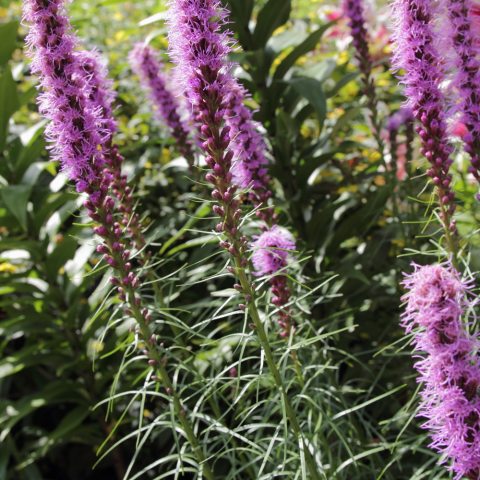
-

-

-

-

-

-

Rose Mallow
Hibiscus moscheutosFind other species of Hibiscus on display throughout the gardens.
-

-

-

-

-

-

-
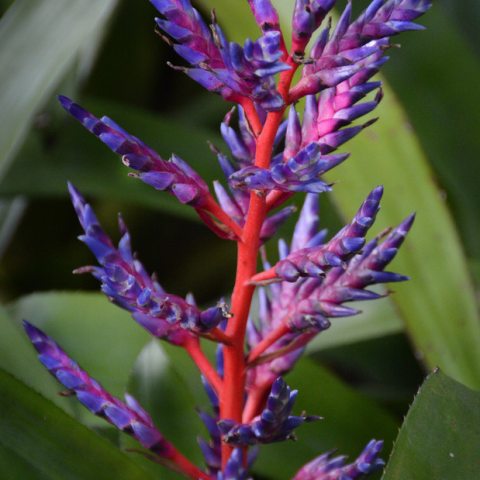
-

-
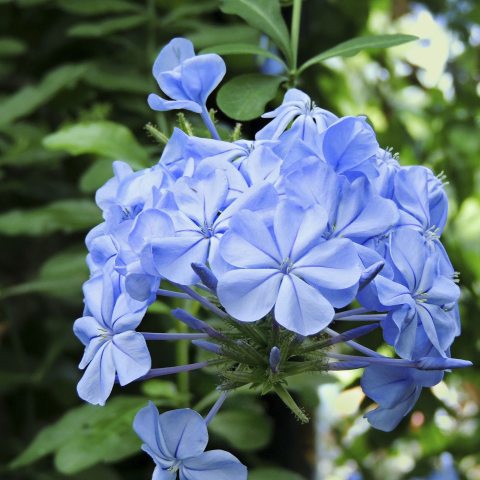
-

-

-

Panicle Hydrangea
Hydrangea paniculataHydrangea paniculata ‘Limelight’ is a well-known cultivar selected by Proven Winners for its reliable performance and striking blooms. Originally developed in the Netherlands, it features large, upright panicles of flowers that open a distinctive pale green in midsummer before gradually shifting to creamy white, pink, and rose tones as the season progresses. This deciduous shrub is adaptable to a variety of soil types and thrives in full sun to partial shade. Growing 6 to 8 feet tall and wide, 'Limelight' is appreciated for its strong stems, long bloom period, and suitability for both garden use and cut flower arrangements.